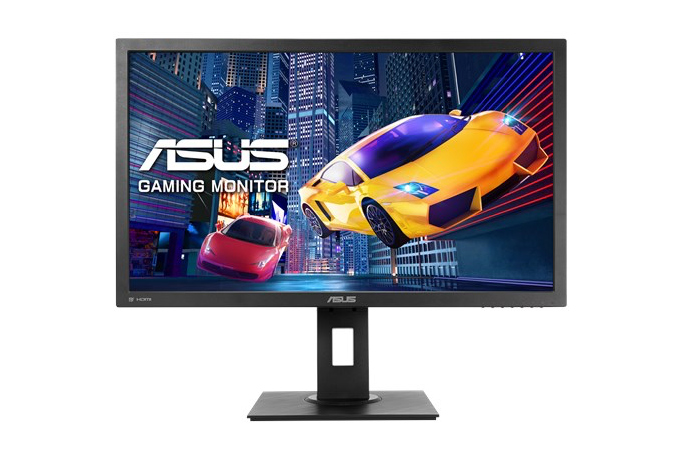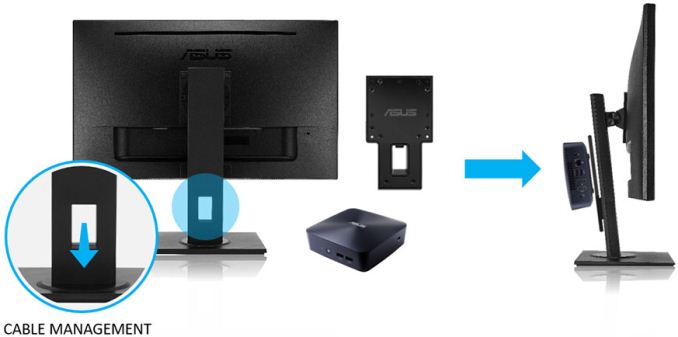ASUS Announces 27-Inch VP278QGL Entry-Level Gaming LCD: 1080p TN w/Freesync
by Anton Shilov on August 10, 2018 11:00 AM EST
ASUS this week is taking the wraps off of a new entry-level gaming monitor that is aimed at satisfying hardcore gamers without breaking the bank. Dubbed the VP278QGL, the 27-inch 1080p monitor sports a TN panel with a 1 ms response time, and a maximum refresh rate of 75Hz. Doubling-down on its gaming focus, the monitor also supports AMD’s FreeSync dynamic refresh rate technology.
Under the hood, the ASUS VP278QGL is based on a 27-inch 6-bit + FRC TN panel featuring a 1920×1080 resolution, a 300 nits brightness, a 1200:1 contrast ratio, 1 ms GtG response time, and 170°/160° horizontal/vertical viewing angles. Specifications of the VP278QGL look typical for contemporary entry-level monitors, but 1 ms response time and AMD’s FreeSync will naturally attract attention of FPS and RTS gamers on a budget to this display. To make the device even more appealing to the target audience, it also supports ASUS’ GamePlus technology features, such as displaying a crosshair, timer and FPS counter.
The VP278QGL display is outfitted with 2W stereo speakers and uses a stand that can adjust height, tilt, swivel, and can rotate pivot clockwise as well as anticlockwise. As for inputs, the monitor has a DisplayPort, two HDMI inputs, and a D-Sub connector.
Details about the ASUS VP278QGL display have been added to the company’s website, but it is unclear when exactly the manufacturer plans to start sales of the product as well as its MSRP. Evidently, the VP278QGL does not belong to the ROG family and is an entry-level product, though precise pricing information isn't available at this time.
| ASUS 27-Inch Gaming Display with 1 ms Response Time | ||
| VP278QGL | ||
| Panel | 27" TN | |
| Native Resolution | 1920 × 1080 | |
| Refresh Rate | 75 Hz | |
| Dynamic Refresh Rate | Technology | AMD FreeSync |
| Range | ? | |
| Response Time | 1 ms (gray-to-gray) | |
| Brightness | 300 cd/m² | |
| Contrast | 1200:1 | |
| Color Saturation | 72 % NTSC sRGB |
|
| Viewing Angles | 170°/160° horizontal/vertical | |
| Inputs | 1 × DisplayPort 2 × HDMI 1 × D-Sub |
|
| Audio | 2 × 2 W speakers | |
| Stand Adjustments | Height Adjustment: 0~130 mm Pivot: +90°~-90° VESA Wall Mounting: 100x100mm Chassis Colors: Black Swivel: +90°~-90° Tilt: +30°~-5° |
|
| Proprietary Enhancements | GamePlus (modes): Timer, Crosshair, FPS Counter, Display Alignment. Splendid Video Preset Modes: Night View Mode, Reading Mode, Game Mode, Standard Mode, Scenery Mode, Darkroom Mode, sRGB Mode/Theater Mode. |
|
| Power Consumption |
Idle | ~0.5 W |
| Active | 20.7 W | |
| Detailed Information | Link | |
Related Reading:
- ASUS Ships ROG Strix XG258Q ‘eSports’ LCD: 1080p 240 Hz Display w/FreeSync
- ASUS Announces ROG Strix XG32VQ and ROG Strix XG35VQ: Large, Curved, & Fast
- ASUS Launches ROG Swift PG27VQ: Curved 27-inch LCD with 165 Hz G-Sync & RGB Lighting
- ASUS ROG Strix XG27VQ Available: 27” Curved, FHD@144Hz & FreeSync w/ELMB
- AOC to Launch Curved QHD Displays with 0.5 ms Response Time in 2018
Source: ASUS











17 Comments
View All Comments
Arnulf - Friday, August 10, 2018 - link
TN must die. IPS panels are dirt cheap nowadays anyway and marginally better response time doesn't offset the lousy viewing angles of TN screens.TN technology had its time before less crappy LCD screen types were invented and just like horse carriages and steam cars needs to be put to rest.
Bat123Man - Saturday, August 11, 2018 - link
Professional gamers all user TN panels because of the 1ms response times. It won't matter to a casual gamer like me, but the best IPS panel is only capable of 4ms. I have to assume that is a world of difference to professional gamers else they would all go for IPS.TheWereCat - Saturday, August 11, 2018 - link
Except the the 1ms and 4ms advertised numbers are absolutely meaningless as the actual response time are both much higher and vary greatly on the particular panel used.Bad TN can have much slower response times than a good IPS.
somejerkwad - Sunday, August 12, 2018 - link
The response time is for grey to grey and becomes irrelevant when you introduce color. That's also just the rating of the panel itself and doesn't factor in the processing time of the scaling hardware that takes data from your input source and feeds it into the screen. Even still, is 4ms really a limit? Does anybody make a screen with a real output frame rate of more than 250Hz? I remember some brands advertising 600Hz TVs a while back, and that was technically true for their backlight strobe but they were still only 60Hz displays at the end of the day.Let's pretend it does matter though. Speed run gamers at the very highest levels of their chosen titles tend to think that single or consecutive single-frame window tricks are difficult to do in real-time, with games at 20 and 30 frames per second, accounting for frame times of 50 or 33 milliseconds. If you cannot consistently react to a window an order of magnitude larger, what's a single digit millisecond difference in absolute greyscale latency going to do for you?
Gen0 - Sunday, August 12, 2018 - link
3 things.1. 4ms as you see on the box is the amount of time it takes for the LCD panel itself to do grey to grey; practically the fastest thing it can do. As a result, it's not actually 'latency' which is the delay between input and onscreen output - a.k.a what we take it for, it's 'max response time' as in the fastest the panel itself can change color ignoring the amount of time it took to get that signal in the first place. In other words 4ms and 1ms are useless numbers.
True latency grey-to-grey for example, would include the amount of time it takes for a GPU to instruct the display to actually draw the first grey. The signal would travel out of the display port at x time, register as making the first grey after x time (usually double digit ms already), then go through the spectra back to grey in 4ms. All the while theres a fixed delay between the screen and the GPU. This differs per type of connector used on just about every display I've had with multiple outs, not least because each protocol has a different amount of overhead and monitors don't come with the most incredible processors built in.
Gen0 - Sunday, August 12, 2018 - link
2. HDTVs can't do more than 60hz because they don't have content that can do more than 60hz. 600hz displays etc etc have super fast strobes to reduce eye fatigue and flicker sickness when using 3D glasses.3. Taking this form my experience of 144hz, it's not about seeing individual frames, it's about motion blur. The slower the frame rate of the screen, the more your eye adds motion blue to stitch the images together. At 144hz, hell at 60hz if you wanna go to youtube and see 1080p 60fps vs 30fps, the difference in your ability to resolve and track objects in motion is huge.
TheWereCat - Friday, August 10, 2018 - link
1080p 27"... Ugh...Gaming monitor - > 75Hz... Ugh...
TN... Ugh...
This better be under $100
somejerkwad - Sunday, August 12, 2018 - link
"Bigger is better" applies and becomes a selling point, oddly enough. Having played close up to large high-end 1080p TVs when they were still cutting-edge, I can say that resolution density isn't everything; I would gladly take a less dense pixel grid with higher overall image quality instead of a silly compromise like the pentile subpixel layout that was utilized to accomplish "1440p" phone displays a few years ago.On 75Hz, I kind of agree but at least it's still more than 60. I'd personally rather have seen 72 so that it doesn't require special user configuration to circumvent the need for pulldown when watching 24fps video content; yeah 120/144 would be even better, but things are built to a price point these days and there does have to be *something* at the bottom end of the market besides "you could get an equivalent monitor for $10 at the thrift shop" options.
wrkingclass_hero - Friday, August 10, 2018 - link
That color gamut... on top of being 6 bit tn... oh boy.Tech_Guru - Friday, August 10, 2018 - link
- Poor color gamut- Poor display panel
- Average-to-Poor refresh rate
. . . Another outdated monitor